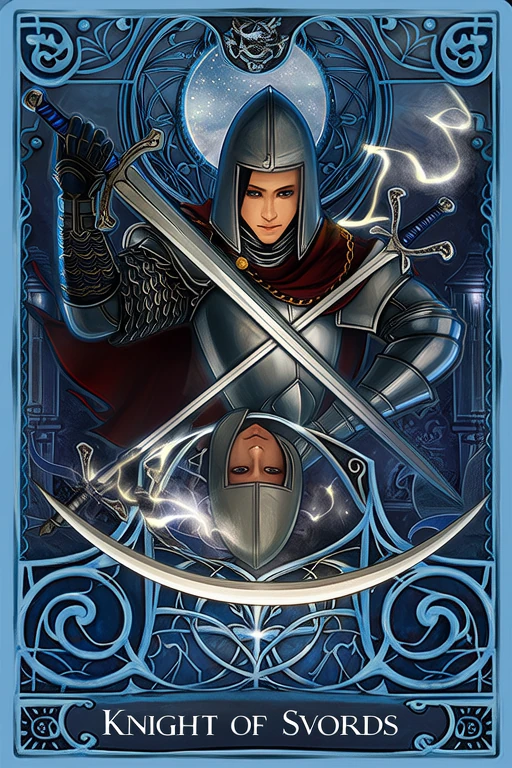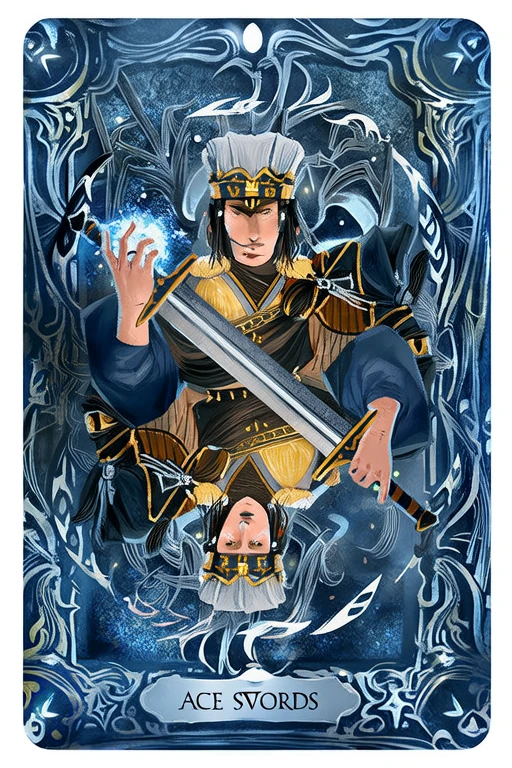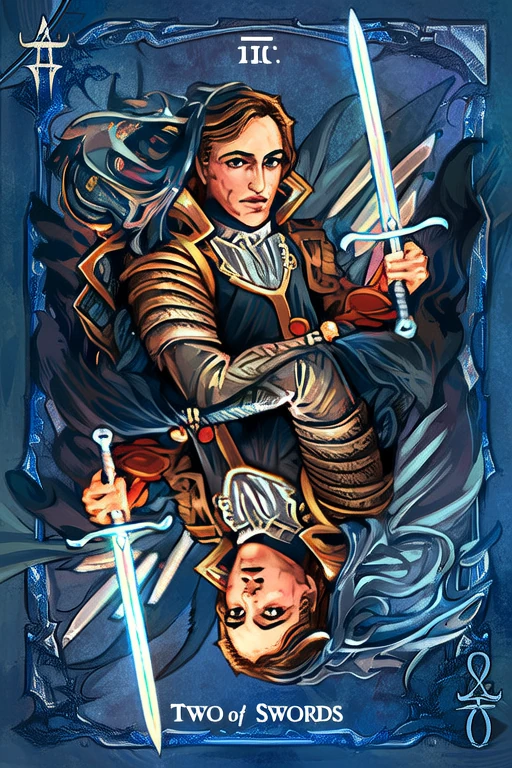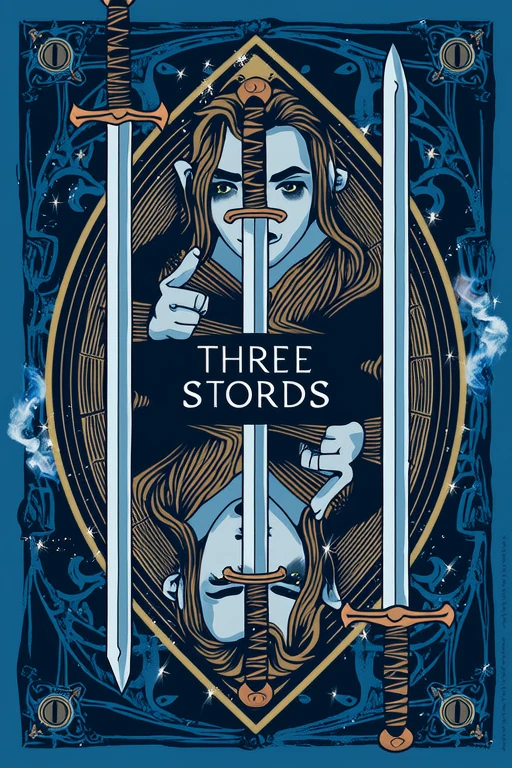
Knight of Swords
Discover the deep meaning of Knight of Swords with our free AI-powered tarot interpretation. Get instant, accurate readings based on advanced tarot knowledge.

Keywords
Upright Meaning
Action, impulsiveness, defending beliefs
Reversed Meaning
No direction, disregard for consequences, unprepared
Full Interpretation
The Knight of Swords represents action, impulsiveness, and defending your beliefs.
In-Depth Analysis
📜 Historical Background
The Knight of Swords, known in traditional tarot decks as the 'Cavaliere di Spade,' has its origins in the early 15th-century tarot decks of Italy, particularly the Visconti-Sforza and Tarot de Marseille. These early decks were not originally used for divination but were playing cards for games among the aristocracy. Over time, especially in the 18th and 19th centuries, tarot evolved into a tool for esoteric and mystical practices, particularly in France and later in England with the rise of the Hermetic Order of the Golden Dawn and the Rider-Waite-Smith deck.
In the Tarot de Marseille, the Knight of Swords is depicted as a stern, armored knight riding a powerful horse, sword raised high, often with a crown above his head. This imagery symbolized authority, action, and decisiveness. The card was associated with the element of air and the suit of swords, which traditionally represents the mind, intellect, and conflict.
As tarot spread across Europe, different cultures adapted the imagery and symbolism of the Knight of Swords to reflect their own values and mythologies. In some Germanic decks, the knight was portrayed as more aggressive or even chaotic, emphasizing the card’s potential for recklessness. In contrast, Italian interpretations often highlighted the knight’s nobility and sense of purpose.
The Rider-Waite-Smith deck, created by A.E. Waite and Pamela Colman Smith in 1909, brought a more narrative and symbolic approach to the card. In this version, the knight is depicted mid-charge, wearing a winged helmet, suggesting swiftness and divine inspiration. His horse rears up, showing both power and instability, while the knight holds a sword upright, symbolizing clarity and direction.
The Knight of Swords has been linked to various historical and mythological figures, including the Greek god Hermes for his speed and messenger role, and the Norse god Odin for his wisdom and battle prowess. In some interpretations, the card is also associated with the archetype of the young warrior or the herald, a figure who brings news, warnings, or urgent messages.
Throughout its evolution, the Knight of Swords has remained a symbol of action, intellect, and urgency. Its presence in a reading often signals a time of rapid movement, decisive thinking, or a need to act swiftly. The card’s rich historical background and varied cultural interpretations make it a compelling and dynamic part of the tarot deck.
Symbolism & Imagery
The Knight of Swords is a richly symbolic card, packed with visual and metaphysical meaning. In most traditional and modern decks, the knight is depicted charging forward on a powerful horse, holding a sword aloft. This imagery conveys movement, determination, and a sense of urgency. The raised sword represents clarity of thought, direction, and intellectual power. The horse, often rearing or in motion, symbolizes untamed energy, ambition, and sometimes recklessness.
Colors play a significant role in the symbolism of the Knight of Swords. In the Rider-Waite-Smith tradition, the knight is often clad in silver or gray armor, colors associated with intellect, logic, and neutrality. The sky behind him may be stormy or dark, indicating the potential for conflict or turbulence. The green cloak worn by the knight in some decks represents growth and renewal, suggesting that the energy of the card, while intense, can lead to positive transformation if channeled correctly.
The winged helmet worn by the knight in the Rider-Waite-Smith deck is a direct reference to Hermes or Mercury, the messenger of the gods in Greek mythology. This symbolizes speed, communication, and the transmission of ideas or messages. The wings also suggest a divine or spiritual component to the knight’s mission, indicating that his actions may be guided by higher knowledge or insight.
Numerologically, the Knights in tarot correspond to the number 12, which in many traditions represents completion, transition, and transformation. The Knight of Swords thus signifies a turning point or a moment of decisive action that leads to change. The number 12 is also associated with the zodiac, and the card’s energy often mirrors the mutable signs—Gemini, Virgo, Sagittarius, and Pisces—particularly in its adaptability and dynamic nature.
In upright position, the Knight of Swords typically represents a person or situation characterized by speed, decisiveness, and a strong will. It can indicate a message, a sudden decision, or an urgent matter that requires immediate attention. However, in reversed position, the card often warns of impulsiveness, rash decisions, or being overwhelmed by circumstances. It may suggest that the querent is acting too hastily or without sufficient reflection, potentially leading to unintended consequences.
Across different cultures and tarot traditions, the Knight of Swords has been interpreted in various ways. In some European decks, the knight is shown with a more aggressive or even destructive demeanor, highlighting the card’s potential for chaos or conflict. In contrast, more modern interpretations, such as those found in the Thoth Tarot by Aleister Crowley, emphasize the card’s intellectual and communicative aspects, linking it to the airy sign of Aquarius and the element of air.
The Knight of Swords also has strong connections to other cards in the tarot deck. It is often seen in conjunction with the Ace of Swords, which represents the initial spark of insight or clarity, and the Two of Swords, which indicates a need for balance or resolution after a period of rapid action. Its presence in a reading often signals movement, change, and the need to act decisively based on clear thinking and intuition.
Psychological Insights
From a psychological perspective, the Knight of Swords resonates deeply with Carl Jung’s concept of archetypes—universal symbols and themes that emerge from the collective unconscious. In this context, the Knight of Swords embodies the archetype of the Warrior or the Hero, representing the drive for action, clarity, and purpose. This card reflects the human capacity for decisive thinking and the courage to act on one’s convictions, even in uncertain or challenging circumstances.
In modern life, the Knight of Swords serves as a powerful symbol for individuals facing pivotal decisions or moments of urgency. It often appears when someone is at a crossroads, needing to make a swift and well-informed choice. This could manifest in career decisions, interpersonal conflicts, or personal transformations. The card encourages the querent to trust their intellect, act with confidence, and not be paralyzed by overthinking or fear of failure.
On a deeper level, the Knight of Swords speaks to the importance of mental clarity and the ability to cut through confusion or misinformation. It represents the power of discernment and the need to remain objective, especially when emotions or external pressures cloud judgment. In this way, the card is a reminder that sometimes, the most effective path forward is the one taken with clarity, precision, and boldness.
For personal growth and self-awareness, the Knight of Swords challenges individuals to examine their motivations and the speed at which they move through life. Are they acting from a place of wisdom and purpose, or are they rushing forward out of fear or impatience? This card invites introspection into how one processes information, makes decisions, and navigates change.
In therapeutic and counseling settings, the Knight of Swords can be a valuable tool for exploring themes of decisiveness, communication, and self-empowerment. Therapists and counselors may use this card to help clients identify patterns of impulsive behavior or hesitation. It can also be used to encourage clients to take ownership of their decisions and to trust their own mental acuity and intuition.
In modern spiritual practices, the Knight of Swords is often associated with quickening energy, spiritual messages, and the need to align one’s actions with higher wisdom. It can appear during periods of spiritual awakening or when a person is called to take a bold step on their spiritual journey. Whether through meditation, journaling, or ritual, engaging with the energy of the Knight of Swords can help individuals harness their inner strength and clarity to move forward with purpose and integrity.
Correspondences
The Knight of Swords corresponds to the element of Air and is associated with the mutable air sign of Aquarius in astrology. This connection emphasizes the card’s themes of intellect, communication, and innovation. The planet Uranus, ruler of Aquarius, further enhances the card’s energy with sudden changes, unexpected insights, and a need for freedom and independence. Occasionally, the Knight of Swords is also linked to Mercury, the planet of communication and thought, reinforcing its role as a messenger or herald of change.
In terms of gemstones and crystals, the Knight of Swords resonates with clear quartz, which enhances mental clarity and amplifies intentions. Amethyst is also aligned with this card, offering balance and spiritual insight to temper the knight’s often impulsive energy. Herbs associated with the Knight of Swords include lavender for calming the mind, mint for mental stimulation, and sage for clearing negative thoughts or energies. Essential oils such as peppermint, eucalyptus, and lemon can help activate the card’s sharp, focused energy and promote clarity of thought.
The Knight of Swords is linked to the season of autumn, a time of transition and change, and is often associated with dawn or early morning, symbolizing new beginnings and the arrival of messages or opportunities. As a card of Air, it aligns with the breath, the mind, and the flow of ideas, making it a powerful tool for communication and intellectual pursuits.
Energetically, the Knight of Swords connects with the third eye chakra (Ajna), which governs intuition, insight, and mental clarity. When this chakra is balanced, the knight’s energy supports decisive action and visionary thinking. However, if overstimulated, it can lead to overthinking or mental fatigue, so grounding and centering practices are recommended when working with this card.
Numerologically, the Knight of Swords is associated with the number 12, which symbolizes transformation, completion, and spiritual awakening. This number appears in various traditions, including the 12 zodiac signs and the 12 months of the year, reinforcing the card’s themes of cycles, change, and movement. The number 12 encourages the querent to embrace transition and to trust in the process of evolution, even when it feels fast-paced or uncertain.
❓ Frequently Asked Questions
The Knight of Swords frequently appears in readings and often raises questions due to its dynamic and sometimes conflicting energy. One of the most common questions about this card is whether it indicates good or bad news. The answer largely depends on the surrounding cards and the context of the question. While the Knight of Swords often signifies action, clarity, and decisiveness, it can also warn against rushing into decisions without proper reflection.
Beginners often misinterpret the Knight of Swords as purely negative or aggressive. However, it’s important to understand that the card represents movement and mental clarity. Its energy is not inherently harmful but can lead to challenges if not properly channeled. Clarifying this misconception helps new readers approach the card with a balanced perspective.
Professional readers often use the Knight of Swords in spreads that require insight into decision-making, communication, or transitions. In a three-card spread, it might represent the action needed or the challenge ahead. In a Celtic Cross spread, the Knight of Swords can appear in the 'challenge' or 'near future' positions, indicating a need for swift action or a message that will soon arrive.
When the Knight of Swords appears alongside other cards, its meaning can shift. For example, paired with the Ace of Cups, it suggests emotional clarity following a period of confusion. With the Tower, it may indicate a sudden and unexpected change. Understanding these interactions allows for more nuanced and accurate readings.
Interpreting the Knight of Swords in different contexts requires attention to the querent’s situation. In career readings, it may signal a promotion, a job offer, or a sudden shift in direction. In relationships, it can represent a new partner entering the scene or a decision that changes the course of a partnership. In health readings, it might suggest a diagnosis or a sudden change in condition. Readers are advised to consider the querent’s mindset and circumstances to provide practical and meaningful guidance.
To work effectively with the Knight of Swords, practitioners should remain open to change, trust their intuition, and avoid impulsive decisions. Meditation on the card’s energy, journaling about recent decisions, or using affirmations such as 'I act with clarity and confidence' can help integrate its lessons into daily life.



